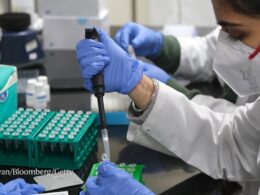After the omicron wave, COVID-19 will return but the pandemic will not.
Key messages (edited by the editor of the blog)
- It is expected that the omicron peak will occur in most countries between now and the second week of February, 2022.
- By March, 2022 a large proportion of the world will have been infected with the omicron variant.
- New SARS-CoV-2 variants will surely emerge and some may be more severe than omicron.
- COVID-19 will become another recurrent disease that health systems and societies will have to manage.
The Lancet, Comment
Christopher J L Murray
Published:January 19, 2022
The world is experiencing a huge wave of infection with the omicron variant of SARS-CoV-2.
Estimates based on Institute for Health Metrics and Evaluation (IHME) models suggest that on around Jan 17, 2022 there were 125 million omicron infections a day in the world, which is more than ten times the peak of the delta wave in April, 2021.
The omicron wave is inexorably reaching every continent with only a few countries in eastern Europe, North Africa, southeast Asia, and Oceania yet to start their wave of this SARS-CoV-2 variant.
The unprecedented level of infection suggests that more than 50% of the world will have been infected with omicron between the end of November, 2021 and the end of March, 2022.
Although IHME models suggest that global daily SARS-CoV-2 infections have increased by more than 30 times from the end of November, 2021 to Jan 17, 2022, reported COVID-19 cases in this period have only increased by six times.,
Because the proportion of cases that are asymptomatic or mild has increased compared with previous SARS-CoV-2 variants, the global infection-detection rate has declined globally from 20% to 5%.
… more than 50% of the world will have been infected with omicron between the end of November, 2021 and the end of March, 2022.
Understanding the burden of omicron depends crucially on the proportion of asymptomatic infections. A systematic review based on previous SARS-CoV-2 variants suggested that 40% of infections were asymptomatic.
Evidence suggests that the proportion of asymptomatic infections is much higher for omicron, perhaps as high as 80–90%.
Garrett and colleagues found that among 230 individuals in South Africa enrolling in a clinical trial, 71 (31%) were PCR positive for SARS-CoV-2 and had the omicron variant and no symptoms.
Assuming this prevalence of infection was representative of the population, the implied incidence compared to detected cases suggests that more than 90% of infections were asymptomatic in South Africa.
The UK Office for National Statistics (ONS) infection survey estimated a point prevalence of PCR positive SARS-CoV-2 infection of 6·85% for England on Jan 6, 2022.
Hospital admission prescreening of individuals without COVID-19 symptoms in the University of Washington Medical Center in Seattle, WA, USA, did not exceed 2% throughout the COVID-19 pandemic but exceeded 10% in the week of Jan 10, 2022 (Murray CJL, unpublished).
In addition to the much larger proportion of asymptomatic infections, in the USA the ratio of COVID-19 hospitalisations to detected cases hospitalised has declined by about 50% in most states compared with previous peaks.
The proportion of COVID-19 patients in hospital who require intubation or are dying has declined by as much as 80–90% in Canada and South Africa.,
Despite the reduced disease severity per infection, the massive wave of omicron infections means that hospital admissions are increasing in many countries and will rise to twice or more the number of COVID-19 hospital admissions of past surges in some countries according to the IHME models.
In countries where all hospital admissions are screened for COVID-19, a substantial proportion of these admissions will be among individuals coming to hospital for non-COVID-19 reasons who have asymptomatic SARS-CoV-2 infection.
Nevertheless, infection control requirements put increased demands on hospitals.
Given population prevalence of SARS-CoV-2 infection of more than 10%, such as reported by the ONS infection survey in London, England, large numbers of health workers are testing positive and are required to quarantine, which puts a double pressure on hospitals.
Countries will need to prioritise support for health systems in the next 4–6 weeks.
Data from Greece, however, hold out hope that severe COVID-19 outcomes from the omicron wave will be limited; from Dec 21, 2021 to Jan 17, 2022 COVID-19 cases increased nearly 10 times but hospital intubations among COVID-19 hospital patients have remained the same as in December.
Countries will need to prioritise support for health systems in the next 4–6 weeks.
Surprisingly, IHME models suggest that the transmission intensity of omicron is so high that policy actions-eg, increasing mask use, expanding vaccination coverage in people who have not been vaccinated, or delivering third doses of COVID-19 vaccines-taken in the next weeks will have limited impact on the course of the omicron wave.
IHME estimates suggest that increasing use of masks to 80% of the population, for example, will only reduce cumulative infections over the next 4 months by 10%.
Increasing COVID-19 vaccine boosters or vaccinating people who have not yet been vaccinated is unlikely to have any substantial impact on the omicron wave because by the time these interventions are scaled up the omicron wave will be largely over.
Only in countries where the omicron wave has not yet started can expanding mask use in advance of the wave have a more substantial effect.
These interventions still work to protect individuals from COVID-19, but the speed of the omicron wave is so fast that policy actions will have little effect on its course globally in the next 4–6 weeks.
The omicron wave appears to crest in 3–5 weeks after the exponential increase in reported cases begins.,
As of Jan 17, 2022, omicron waves were peaking in 25 countries in five WHO regions and in 19 states in the USA.
It is expected that the omicron peak will occur in most countries between now and the second week of February, 2022.
The latest omicron peaks are expected to come in the countries where the omicron wave has not yet started, such as in eastern Europe and southeast Asia.
It is expected that the omicron peak will occur in most countries between now and the second week of February, 2022.
Actions to increase SARS-CoV-2 testing, for example, are likely to increase disruption by having more individuals excluded from work or school, but are unlikely to impact the course of the omicron wave.
In the era of omicron, I believe that COVID-19 control strategies need to be reset. Given the speed and intensity of the omicron wave, in my view efforts to contact trace seem to be futile.
In the era of omicron, I believe that COVID-19 control strategies need to be reset. Given the speed and intensity of the omicron wave, in my view efforts to contact trace seem to be futile.
A question remains in relation to the countries pursuing zero COVID-19 strategies, such as China and New Zealand. China has local omicron transmission in January, 2022.
Given the high transmissibility of omicron, it seems unlikely that China or New Zealand will be able to permanently exclude the omicron wave.
For zero COVID-19 countries, the question will be one of timing.
Later omicron surges will allow further progress on increasing vaccination coverage and better understanding of the impact of the omicron variant in a fairly immunologically naive population.
Given the high transmissibility of omicron, it seems unlikely that China or New Zealand will be able to permanently exclude the omicron wave
By March, 2022 a large proportion of the world will have been infected with the omicron variant.
With continued increases in COVID-19 vaccination, the use in many countries of a third vaccine dose, and high levels of infection-acquired immunity, for some time global levels of SARS-CoV-2 immunity should be at an all time high.
For some weeks or months, the world should expect low levels of virus transmission.
I use the term pandemic to refer to the extraordinary societal efforts over the past 2 years to respond to a new pathogen that have changed how individuals live their lives and how policy responses have developed in governments around the world.
These efforts have saved countless lives globally.
New SARS-CoV-2 variants will surely emerge and some may be more severe than omicron. Immunity, whether infection or vaccination derived, will wane, creating opportunities for continued SARS-CoV-2 transmission. Given seasonality, countries should expect increased potential transmission in winter months.
New SARS-CoV-2 variants will surely emerge and some may be more severe than omicron.
The impacts of future SARS-CoV-2 transmission on health, however, will be less because of broad previous exposure to the virus, regularly adapted vaccines to new antigens or variants, the advent of antivirals, and the knowledge that the vulnerable can protect themselves during future waves when needed by using high-quality masks and physical distancing.
COVID-19 will become another recurrent disease that health systems and societies will have to manage.
For example, the death toll from omicron seems to be similar in most countries to the level of a bad influenza season in northern hemisphere countries.
The US Centers for Disease Control and Prevention estimated the worse influenza season during the past decade in 2017–18 caused about 52 000 influenza deaths with a likely peak of more than 1500 deaths per day.
The era of extraordinary measures by government and societies to control SARS-CoV-2 transmission will be over.
After the omicron wave, COVID-19 will return but the pandemic will not.
… the worse influenza season during the past decade in 2017–18 caused about 52 000 influenza deaths (USA, cdc)
COVID-19 will become another recurrent disease that health systems and societies will have to manage.
References
See the original publication
DOI: https://doi.org/10.1016/S0140-6736(22)00100-3
Originally published at https://www.thelancet.com.
About the author
Christopher J L Murray
Affiliations
Institute for Health Metrics and Evaluation, Seattle, WA 98105, USA












